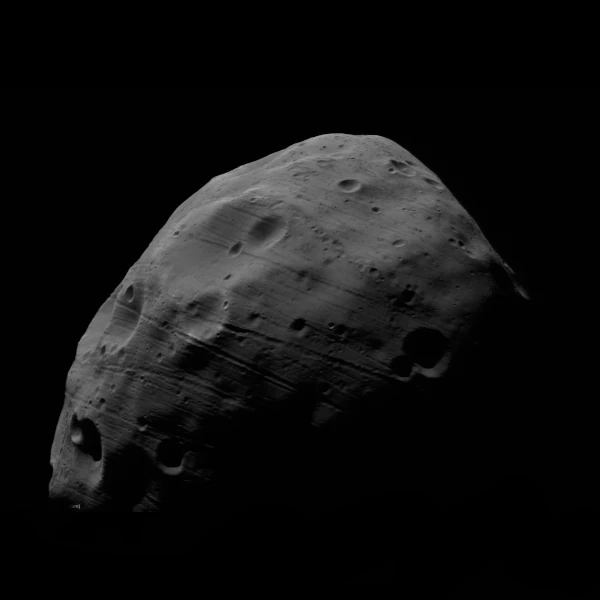
Phobos is the closest of Mars’ two moons, with a mean radius of 11.1 km and an orbit only 5,989 km above Mars’ surface. Its orbital period of 7 h 39 min is shorter than Mars’ rotation, making it a sub-synchronous orbit. Due to tidal forces, Phobos’ orbital energy slowly decreases, causing its orbit to spiral gradually toward the planet.
Note:
A sub-synchronous orbit is an orbit whose period is shorter than the planet’s rotation. In this case, the satellite moves faster than the planet rotates beneath it. Tidal forces caused by this speed difference transfer angular momentum from the orbit to the planet, resulting in a slow spiraling toward the surface. Conversely, a super-synchronous orbit (orbital period > planetary rotation) causes the satellite to gradually move away.
Altimetric measurements from the Mars Global Surveyor (NASA) show that Phobos is approaching Mars by about 1.8 cm per year. This will lead to a collision or gravitational breakup in roughly \(3 \times 10^7\) years. According to calculations by Robert Burns (1964), the stability limit is defined by the Roche limit: \( d_R = R_p \times 2.44 \left( \frac{\rho_p}{\rho_s} \right)^{1/3} \) where \(R_p\) is Mars’ radius, \(\rho_p\) its average density, and \(\rho_s\) the satellite’s density. When Phobos reaches this distance, approximately 2.4 Mars radii, its internal stresses will no longer resist tidal forces, causing it to fragment into a temporary ring around Mars.
Phobos’ origin remains debated. Its low density (\(\rho_s \approx 1.88\ \text{g.cm}^{-3}\)) and very low albedo (0.07) suggest a composition rich in silicates and carbon, similar to C-type asteroids. Two main scenarios are considered:
High-resolution images from the Mars Reconnaissance Orbiter reveal cracks hundreds of meters long on Phobos’ surface. These features indicate internal deformation due to tidal stresses. Simulations by Terry Hurford (2014) show these cracks extend along the direction of maximum tension imposed by Mars. This confirms that Phobos is not a homogeneous block, but rather a rubble-pile whose cohesion partly depends on its weak self-gravity.
Compared to its sister Deimos, Phobos illustrates two opposite fates: one disintegrates slowly, the other gradually moves away. These opposite trajectories result from their positions relative to the Martian synchronous orbit.
| Characteristics | Phobos | Deimos | Comment |
|---|---|---|---|
| Mean radius | 11.1 km | 6.2 km | Data from Martian missions and technical summary: NASA — Phobos (Science) |
| Orbital altitude | 5,989 km | 23,460 km | Phobos is ~4 times closer to Mars than Deimos |
| Orbital period | 7 h 39 min | 30 h 18 min | Phobos completes more than 3 orbits during one Martian rotation |
| Orbital evolution | Approaching Mars (−1.8 cm/year) | Gradually moving away (+0.2 cm/year) | Opposite tidal dynamics depending on position relative to the synchronous orbit |
Sources: NASA, ESA, NASA ADS, Science@NASA.